The State of (Over)working 2025
Resource Guru’s research reveals the extent of the UK’s overworking and burnout issues, using survey data from 2,000 desk workers, alongside expert insights.
Agency life is infamously fast-paced. Workloads are heavy, clients constantly ask for more, and workers are burning out. Agency leadership is also struggling to keep up; resorting to reactive, stop-gap solutions.
In this report, we aim to go deeper. We question why, consult the experts, and scrutinize the data, based on our survey of agency employees*. We also share key takeaways that can help agencies protect profitability while improving the employee experience, project outcomes, and client satisfaction.

“The Resource Guru journey began in creative agencies. We’ve seen first-hand how overworking and burnout affect individual and business performance, and combating that is something we continue to feel passionately about.
We commissioned this survey to better understand why employees at agencies are still struggling with unmanageable workloads, and what more can be done to fix that.”
We’ve brought together leading industry voices to help interpret the data and share practical solutions:
We also spoke with several current and former agency employees to get their insider perspective and learn from their personal experiences.
In this report, we’re specifically speaking about agencies that service clients. Workers at these kinds of companies are known for being passionate, inventive, and driven.
However, no amount of drive can keep them going when they’re running on empty. Our data shows they’re putting in as much effort as possible, but at what cost?
Agency life has always been hectic but, in 2025, overtime is far more common than not.
Whether they’re putting in the hours racing to meet a deadline, working on yet another version of a client asset, or clearing out endless inboxes, the boundaries between work and life are increasingly blurred.
Burnout expert Leanne Spencer speaks to the negative effects of being “always on”:
“Burnout carries significant costs for agencies. It can lead to absences and presenteeism (where someone looks productive, but their productivity levels are actually low), which both impact business performance.
The pressure is piling up, and employees are cracking under it. Of those agency workers we surveyed:
These aren’t just numbers on a screen. Each one reflects the lived experience of individuals working at agencies. It’s clear people’s lives are being profoundly affected by expectations of constant output.
The survey confirmed that burnout isn’t uncommon among those who work at agencies.

Find the answer using our free Burnout Risk Index tool.
Further reading: Read more about the signs of agency burnout.
The cost of intense agency demands is now spreading to individuals’ health and personal lives.
The extent of the effects of overworking is leading agency teams to seek serious medical interventions. Of those who are burned out:
“These issues lead to intense pressure on healthcare systems. They have to try to keep up with the ever-growing number of workers who need medical assistance due to burnout.”
These consequences aren’t just isolated to time spent at work. They leak into relationships, routines, and self-esteem too.
Of those reporting burnout:
Burnout evidently affects individual wellbeing, but burnout is also causing negative effects for agencies’ bottom lines.
Hot take:
“Ignoring burnout risks both reputation and results for agencies.” – Leanne Spencer
Here are three causes for concern leadership should take note of that are prompted by agency teams working too hard:
Overworked teams don’t just struggle. They’re often forced to take time off work, or leave their workplace altogether.
Of those reporting stress, anxiety, and depression, they’re also seeing effects on their personal performance at work:
“Agencies are nothing without the people who work at them. As such, the effects of overwork and burnout are going to negatively affect these businesses’ metrics and outcomes eventually.
While addressing these problems is the ‘right thing’ to do for your team, it’s also essential if you want your agency to be successful in the long run.” – Dr. Matthew Chan
Due to the personal challenges faced by burned out agency workers, many admit to producing work that falls below their usual standards.
Of those burned out:
“You’re more likely to make mistakes when you’re tired. And, if you’re being rushed, how can you really think clearly? How are you doing your best work under those circumstances?” – MS, SEO, Ex-Publicis
Next, let’s break down the key drivers of overworking and burnout, and the proactive solutions agency leaders can implement to address them.
Our data shows there’s not just one reason why people working at agencies are prone to being pushed to extremes. Several factors contribute to regular excessive working. Here are the five key drivers that emerged from our research:
Here are some of the negative experiences agency workers have had with their clients that are connected to excessive working:
And, 46% of burned out agency workers say demanding clients caused their burnout.
Agencies couldn’t exist without the clients that (quite literally) pay their bills. And, while many have healthy working relationships with their clients, that’s not always the case.
Unbalanced relationship dynamics where the “client is king” are causing serious strain. This leads agency teams to stop at nothing to protect client satisfaction and client retention.
“It starts and stops at the client. They are the ones who determine if you’ve done a good job or not, how much money you get paid, how much of a bonus you get.” – DD, PR, Ex-M&C Saatchi
Given the fierce competition between agencies to secure new business, there is often a fear that, if clients don’t perceive the agency’s work or approach as “good enough” they’ll opt for a different agency. This can cause problems for the original agency in two ways: it threatens agency revenue, and can cost the account manager their professional reputation.
Rob also observes that constantly giving in to whatever clients ask for leads to scope creep, which also contributes to overworking:
“Agencies are notoriously bad at managing scope creep. Small, uncharged requests from demanding clients build up, completely derailing resource plans and forcing teams to deliver more for less.”
So, what can be done about it?
Sure, it’s a tad cliché, but good relationships are built on clear communication. That extends to the agency-client relationship too.
Key to that is being transparent about what’s included in the work you’ll deliver for a client. This is about setting boundaries, building a clear scope of work and, as the work progresses, explaining how changes to the plan affect delivery times.
“For staff, the mantra is: make the invisible visible. Every extra client request must be met with a clear ‘if-then’ response: ‘If you want this new feature, then the original deadline moves.’
For leadership, the job is to stop the problem upstream. Enforce iron-clad scopes of work and give your team the authority to hold that line. Don’t make your people fight battles you failed to prevent contractually.” – Rob Sayles
One foundational step that facilitates these conversations and agreements is using purpose-built resource management and project management tools.
By having a central system in place where they manage each client project, agencies can set realistic expectations, share real-time status updates, and accurately analyze project performance.
AI is often touted as a game-changer when it comes to efficiency. However, our survey shows agency workers are often experiencing the opposite.
Instead of saving them time, many respondents said integrating AI into their workflows has created more work for them.
“AI is exposing the cracks in the traditional agency model. Agencies should proactively educate clients on the human effort required to deliver quality AI-assisted work, while simultaneously re-engineering their own internal processes to truly embrace AI (not just as a superficial tool).” – Rob Sayles
Both workloads and deadlines were cited as causes of burnout in our survey results:
On the topic of deadlines, agency workers highlighted a number of personal sacrifices they have to make to deliver work on time, including:
When agency capacity planning is unrealistic, or ignored completely, an imbalance occurs. The amount of people and resources available to get the work done, and the amount of client work they’re expected to complete, is unmanageable. That naturally leads to increased pressure on agency workers.
On top of intense workloads, agencies also operate on a time crunch. Each client project also comes with a deadline and, more often than not, they’re as tight as possible to protect agency profitability.
But what’s the answer to that? How can agencies manage to remain profitable while also keeping workloads and timelines fair?
When asked how agency leadership can set more realistic deadlines for their staff, Rob had this to say:
“Stop guessing. Realistic deadlines are built on data, not gut feelings. Use your past project performance to build a reliable forecasting model. If the data shows a proposed deadline is a fantasy, a leader’s job is to protect their team’s sanity, not a client’s unrealistic wish.” – Rob Sayles
However, this data is unfortunately sometimes siloed at agencies, particularly if they’re using disparate systems to manage projects, people, and resources.
To get true insights from projects that are already complete, a dedicated system that connects the dots on all the agency’s efforts—and allows you to report on the same—is a necessity.
On top of client expectations, heavy workloads, and deadlines, agency teams also deal with internal pressures that are causing a cycle of overworking.
Agency workers who don’t put in extra hours fear being seen as uncommitted by their managers and clients. Additionally, agency leadership may glorify those who put in the effort into client work beyond normal working hours due to client pressures. This can make workers feel they need to show up in this way in order to be recognized.
Rob tells us one of the best ways to address these cultural expectations is to actively manage clients who don’t respect the agreed parameters for projects:
“The cure for burnout is found in commercial discipline. It means defending project scope and having the courage to handle (or fire) clients who don’t respect your most valuable asset: your people’s time.” – Rob Sayles
The first step in being able to defend your project scope, and the people working on that project, is to develop a deep understanding of all the moving parts involved.
Once again, this is where a formal approach to resource management (including your choice of resource scheduling software) comes in. By centralizing where you manage your people and resources, you can keep an eye on how projects are progressing, spot scope creep, and flag it with clients before it becomes a major issue.
Further reading: Explore our seven-step guide to revitalising your agency culture.
This cause of burnout and overworking underpins the other three we’ve discussed so far.
The data shows that the way agency staff, their workloads, and their time is managed is not on par with the level of organization and efficiency they need to keep up.
Of those reporting burnout at agencies:
Poor resource and time management is connected to a range of other problems:
“If there’s no written allocation, there’s a risk that the work will just keep piling on, so it’s crucial to plan.” – MJ, New Business, TAG WW (Dentsu Subsidiary)
Agencies lack the right systems to distribute workloads fairly, ensure teams aren’t overburdened, and accurately track their time. Without those mechanisms in place, there’s a disconnect between the availability and capacity teams have, and the workloads they’re assigned.
There’s no transparency between those assigning the work and those executing it. There’s also no single source of truth to track project performance in real-time, which can lead to a perpetual cycle of overstretched agency teams.
Rob recommends agencies modernize their approach to resource and time management, and move away from the likes of Google Sheets. This will not only protect their employees, but their businesses as a whole.
“Running an agency on spreadsheets is like driving at night with the headlights off: you only see problems after you’ve hit them.
A dedicated resource management tool gives you foresight: a single source of truth that shows who’s available, what’s profitable, and where the next resource crunch is coming from. It’s the difference between constant firefighting and actually future-proofing your business.” – Rob Sayles
Resource Guru is fast, flexible resource management software that helps agencies actively prevent overworking and burnout by providing clear insight into capacity and flexible ways to plan projects.
In a nutshell, here’s how it helps agencies:
Our clash management engine provides alerts when allocating work to someone who’s at capacity, or unavailable. This helps prevent excessive amounts of client work being assigned to individuals.
Approval workflow also means bookings have to get the green light before they’re confirmed. This also helps protect in-demand agency employees.

“[Resource] Guru has helped us organize a very busy agency. We’ve been able to better spread work across resources and increase everyone’s utilization.”
Dedicated resource management software makes it possible to understand the entire agency workload and capacity. Agency utilization rate tracking on Resource Guru makes it simpler to understand who’s overburdened with deadlines, and who can take on more client work.
You get a clear overview of team utilization via heatmap views and can analyze trends in depth with customizable reports.
Pro tip:
“Capacity planning is the bedrock of agency profitability. It’s the only real bridge between a sales promise and a delivery reality. Get it right, and you can accurately forecast revenue and protect your team. Get it wrong, and you’re just planning your next crisis.” – Rob Sayles
Outline timelines, create milestones, and track budgets to keep projects on track. Even before projects kick off, you can use resource placeholders to plan out unconfirmed client work before it commences. That way, you can make sure you have enough space to take on work before you commit.

“[Resource Guru] really enables me to keep on track of my workload and stay organised in a fast paced agency. Very useful indeed. Couldn’t work without it.”
You can gain insight into scheduled vs. actual hours worked to monitor if teams are being overburdened.
Our timesheets are easy for teams to complete and managers to analyze because they auto-fill based on booked work, take a click to submit, and have built-in approvals.
On the client side, they gain transparency because you can share this insight to showcase how scope creep can push projects off track. This more informed communication can help build trust and, ultimately, healthier working relationships.

Join thousands of project managers who have made scheduling a breeze.

“These Resource Guru features have been proven to reduce excessive workloads, increase productivity, improve the employee experience, and help agencies deliver profitable projects.
After all, happy teams drive successful businesses.”
– Percy Stilwell
*This online survey of 2,000 UK desk workers (373 of whom work at agencies) was commissioned by Resource Guru and conducted by market research company OnePoll, in accordance with the Market Research Society’s code of conduct.
All data in this report was based only on responses from those screened as agency workers “I work at an agency that services clients (agency-side)”.
Data was collected between [07/02/2025] and [19/02/2025]. All participants are double-opted in to take part in research and are paid an amount depending on the length and complexity of the survey.
This survey was overseen and edited by the OnePoll research team. OnePoll are MRS Company Partners, corporate membership of ESOMAR and Members of the British Polling Council. Respondents were screened to confirm they worked primarily at a desk in an office or home setting.
The sample included a mix of respondents across age groups, genders, industries/job roles, and UK regions.
Expert commentary was gathered after the survey was completed, based on a summary of the key findings.

Resource Guru’s research reveals the extent of the UK’s overworking and burnout issues, using survey data from 2,000 desk workers, alongside expert insights.

Amirreza Farhadi is the Associate VP of Operations at Havas CX Canada. Part of Havas’s senior leadership team, he builds, monitors, and improves processes to ensure the business runs smoothly. In his eyes, that starts with…

Kathryn E. Strachan launched B2B content marketing agency CopyHouse as a one-woman band in 2019. After landing Scottish Widows as a freelancer, she quickly needed to set up an LTD. Four years later, she has a…